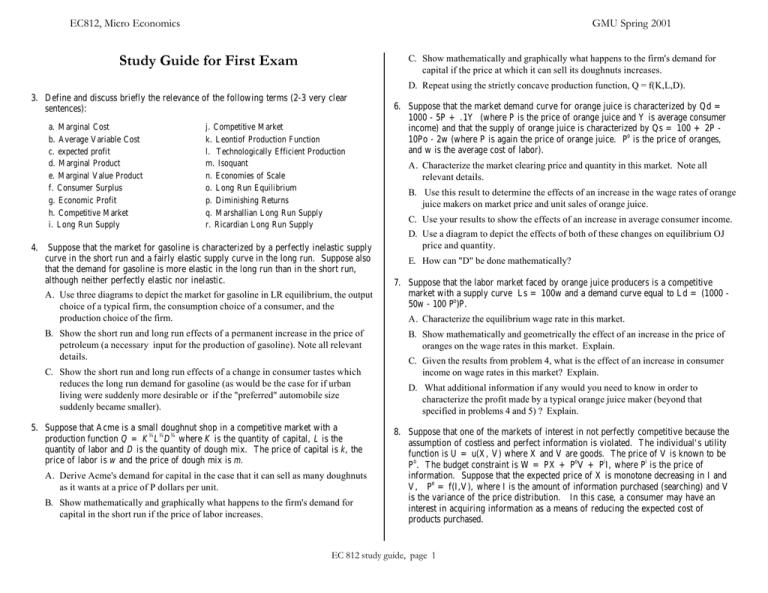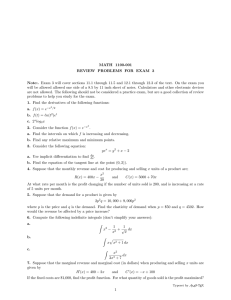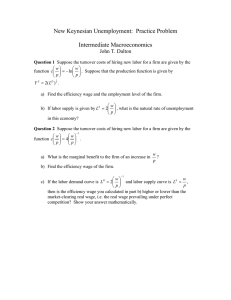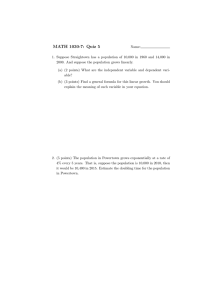Study Guide for First Exam
advertisement

EC812, Micro Economics GMU Spring 2001 Study Guide for First Exam C. Show mathematically and graphically what happens to the firm's demand for capital if the price at which it can sell its doughnuts increases. D. Repeat using the strictly concave production function, Q = f(K,L,D). 3. Define and discuss briefly the relevance of the following terms (2-3 very clear sentences): a. Marginal Cost b. Average Variable Cost c. expected profit d. Marginal Product e. Marginal Value Product f. Consumer Surplus g. Economic Profit h. Competitive Market i. Long Run Supply j. Competitive Market k. Leontiof Production Function l. Technologically Efficient Production m. Isoquant n. Economies of Scale o. Long Run Equilibrium p. Diminishing Returns q. Marshallian Long Run Supply r. Ricardian Long Run Supply 4. Suppose that the market for gasoline is characterized by a perfectly inelastic supply curve in the short run and a fairly elastic supply curve in the long run. Suppose also that the demand for gasoline is more elastic in the long run than in the short run, although neither perfectly elastic nor inelastic. A. Use three diagrams to depict the market for gasoline in LR equilibrium, the output choice of a typical firm, the consumption choice of a consumer, and the production choice of the firm. B. Show the short run and long run effects of a permanent increase in the price of petroleum (a necessary input for the production of gasoline). Note all relevant details. C. Show the short run and long run effects of a change in consumer tastes which reduces the long run demand for gasoline (as would be the case for if urban living were suddenly more desirable or if the "preferred" automobile size suddenly became smaller). 5. Suppose that Acme is a small doughnut shop in a competitive market with a production function Q = K¼L¼D¼ where K is the quantity of capital, L is the quantity of labor and D is the quantity of dough mix. The price of capital is k, the price of labor is w and the price of dough mix is m. A. Derive Acme's demand for capital in the case that it can sell as many doughnuts as it wants at a price of P dollars per unit. B. Show mathematically and graphically what happens to the firm's demand for capital in the short run if the price of labor increases. 6. Suppose that the market demand curve for orange juice is characterized by Qd = 1000 - 5P + .1Y (where P is the price of orange juice and Y is average consumer income) and that the supply of orange juice is characterized by Qs = 100 + 2P 10Po - 2w (where P is again the price of orange juice. Po is the price of oranges, and w is the average cost of labor). A. Characterize the market clearing price and quantity in this market. Note all relevant details. B. Use this result to determine the effects of an increase in the wage rates of orange juice makers on market price and unit sales of orange juice. C. Use your results to show the effects of an increase in average consumer income. D. Use a diagram to depict the effects of both of these changes on equilibrium OJ price and quantity. E. How can "D" be done mathematically? 7. Suppose that the labor market faced by orange juice producers is a competitive market with a supply curve Ls = 100w and a demand curve equal to Ld = (1000 50w - 100 Po)P. A. Characterize the equilibrium wage rate in this market. B. Show mathematically and geometrically the effect of an increase in the price of oranges on the wage rates in this market. Explain. C. Given the results from problem 4, what is the effect of an increase in consumer income on wage rates in this market? Explain. D. What additional information if any would you need to know in order to characterize the profit made by a typical orange juice maker (beyond that specified in problems 4 and 5) ? Explain. 8. Suppose that one of the markets of interest in not perfectly competitive because the assumption of costless and perfect information is violated. The individual's utility function is U = u(X, V) where X and V are goods. The price of V is known to be Po. The budget constraint is W = PX + PoV + PiI, where Pi is the price of information. Suppose that the expected price of X is monotone decreasing in I and V, Pe = f(I,V), where I is the amount of information purchased (searching) and V is the variance of the price distribution. In this case, a consumer may have an interest in acquiring information as a means of reducing the expected cost of products purchased. EC 812 study guide, page 1 EC812, Micro Economics GMU Spring 2001 A. Characterize the quantity of information that this consumer should purchase. Explain. B. How does the demand for information change as the variance of the price distribution changes? As W? 9. A small fishing firm's production function for fish is given by Q = aK.25L.50F.25 where L is labor input per day, K is the size of the trawler, F is the number of Fish in the area being fished, a is a positive constant less than one, and Q is the average output of fish (the catch) per day. A. Derive the firm's short run demand for labor if the fish sells for $3/lb in a competitive market. B. If the market wage is $30 per day, how many workers will the firm hire? If the wage is fixed but the price of widgets varies with changing demand, derive the demand for labor as a function of the price of fish. C. Show how a sudden reduction in the pool of fish to be caught would affect the firm's short run profit and its demand for labor. D. Suppose that the cost of capital and labor are both $30.00, find this firm's total cost function. E. Repeat using the strictly concave production function Q=f(K,L,F). 2 10. Suppose that Al has the utility function U = Y L, defined over labor income Y, and leisure, L. Al can allocate 16 hours a day between paid labor and leisure. A. Determine Al's supply of labor function if he earns w $/hr while at work. (Hint: note that Y = w(1-L). ) B. Is Al's supply of labor function monotone increasing in the wage rate? 11. Suppose that automobile size (weight) and gasoline are inputs into the household production of transport services, T = t( S, G), with T increasing as G increases but decreasing as S increases. Suppose also that travel is a bit risky, and that the probability of an accident increases with travel, P = p(T), while the damage generated falls as automobile size increases, H = Ho - d(S), other things being equal. If no accidents occur, damages equal zero, e. g. H = H0. Assume that individuals value only health, H, transport services, T, and other consumption, C. A. Characterize a typical person's (Al's) expected utility maximizing automobile size. (Assume that Al has W dollars to allocate between C, S, and G which are purchased in competitive markets.) Explain the economics behind the mathematics that characterizes Al's optimum. C. Does Al's short run demand for gasoline necessarily slope downward when Al's utility function is separable and strictly concave? Briefly explain your analysis. 12. Analyze the following economic puzzles: A. "The distinction between the long run and the short run is a fiction with no counterpart in the real world." Evaluate this criticism, explaining why one might make such a statement, but show how this fictional distinction might be defended. B. In macroeconomic analysis, the possibility of economic equilibrium with a degree of unemployment is ordinarily assumed. But in microeconomic analysis, we generally postulate that prices must be such to clear markets. Is it possible to give a microeconomic explanation for unemployment, without calling upon wage rigidities due to government or union action to keep wage rates from falling? C. The concept of marginal utility is subject to the objection that it implies a numerical measurement of total utility. (i) Can we overcome this difficulty? (ii) Is it important that we do so? (iii) Translate into terms which do not involve the cardinal measurement of utility: the law of diminishing marginal utility, and the Pareto optimality condition that the ratio of the marginal utilities of two goods must equal for all individuals in a free-exchange economy. 13. Consider the plight of a husband. His utility function is U(c,a), where c is his annual consumption and a is the amount of “female attention” he receives in a given year. Assume Uc >0 and Ua >0. Female attention, a, is bestowed by the husband's wife, with a=f(g,t), where y is the annual amount of gifts (of consumption goods) the husband gives to his wife, and y is how long they have been married. The husband earns a fixed income W (of consumption goods) each year. A. Write out the optimization problem faced by the husband each year. Clearly label his choice variables, his objective, and any constraints he faces. Use calculus to solve for the husband's optimal choices, and verbally interpret any first-order conditions. B. Suppose fg>0 and fy <0. Interpret these conditions verbally. How would the evolution of the marriage depend on the sign and magnitude of fgy ? Use the logic of income and substitution effects to explain what happens to the husband's gift giving as the marriage matures. C. Mathematically show how the duration of the marriage, y, affects gift giving by the husband. Explain your results. B. Characterize Al's demand function for automobile size. EC 812 study guide, page 1





